A Study of Employee Retention Management at Emirates NBD Bank
VerifiedAdded on 2023/01/16
|40
|11446
|58
Report
AI Summary
This report is a comprehensive study of employee retention within Emirates NBD, a major banking group in the UAE. The research delves into the crucial aspects of employee retention, including the impact of leadership styles, the effectiveness of training and development programs, and the role of incentives in motivating and retaining talented employees. The study examines the background of employee retention, its significance, and the research questions guiding the analysis. The literature review explores existing research on employee retention, leadership styles, incentives, and training programs. The methodology outlines the research approach, data collection methods, sampling techniques, and data analysis strategies employed. The data analysis chapter presents the findings, potentially including questionnaire responses and interpretations. Finally, the conclusion and recommendations chapter summarizes the key findings and suggests strategies for improving employee retention within Emirates NBD, offering valuable insights for organizational improvement. The report is available on Desklib, a platform dedicated to providing AI-powered study tools and resources for students, offering past papers and solved assignments.
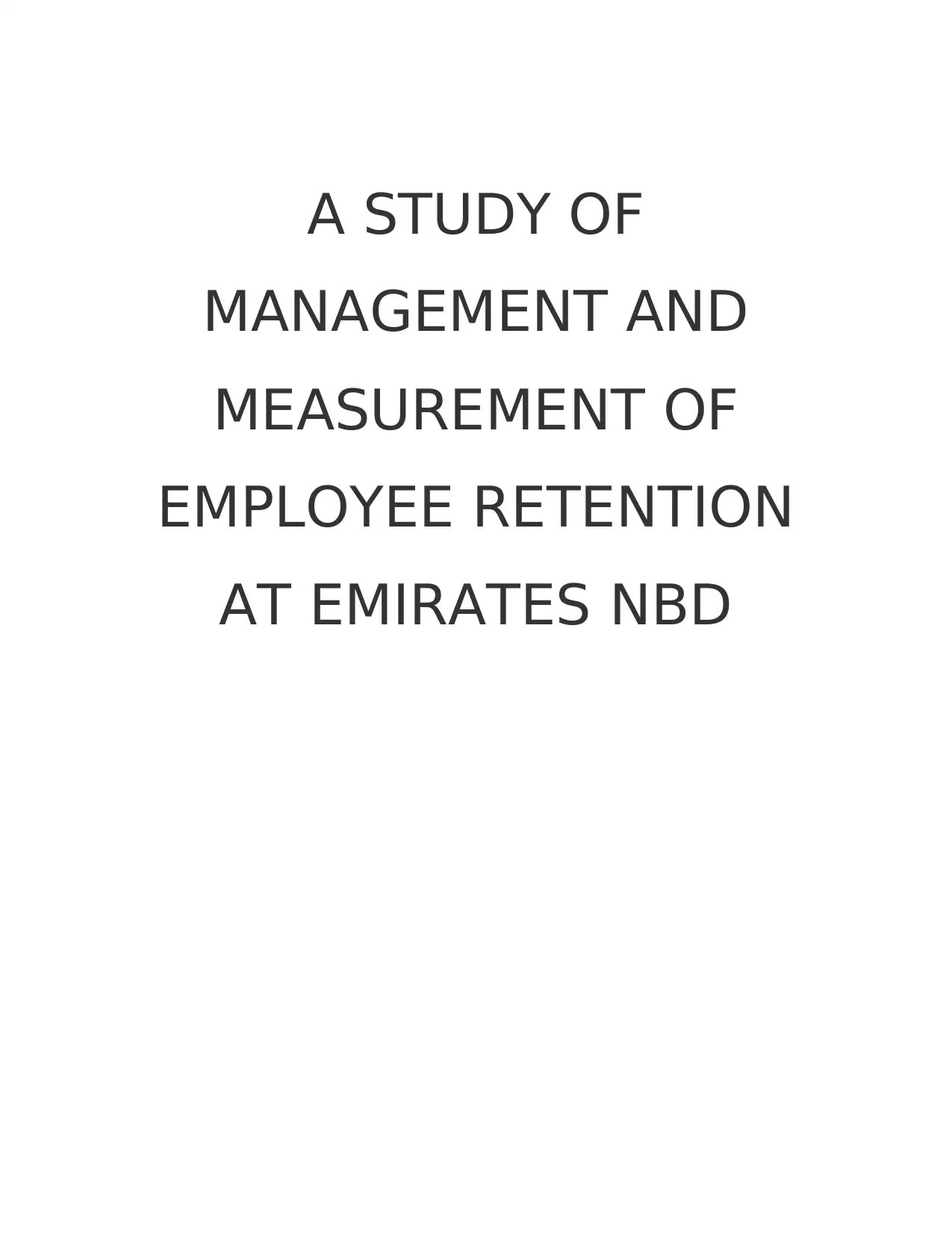
A STUDY OF
MANAGEMENT AND
MEASUREMENT OF
EMPLOYEE RETENTION
AT EMIRATES NBD
MANAGEMENT AND
MEASUREMENT OF
EMPLOYEE RETENTION
AT EMIRATES NBD
Paraphrase This Document
Need a fresh take? Get an instant paraphrase of this document with our AI Paraphraser
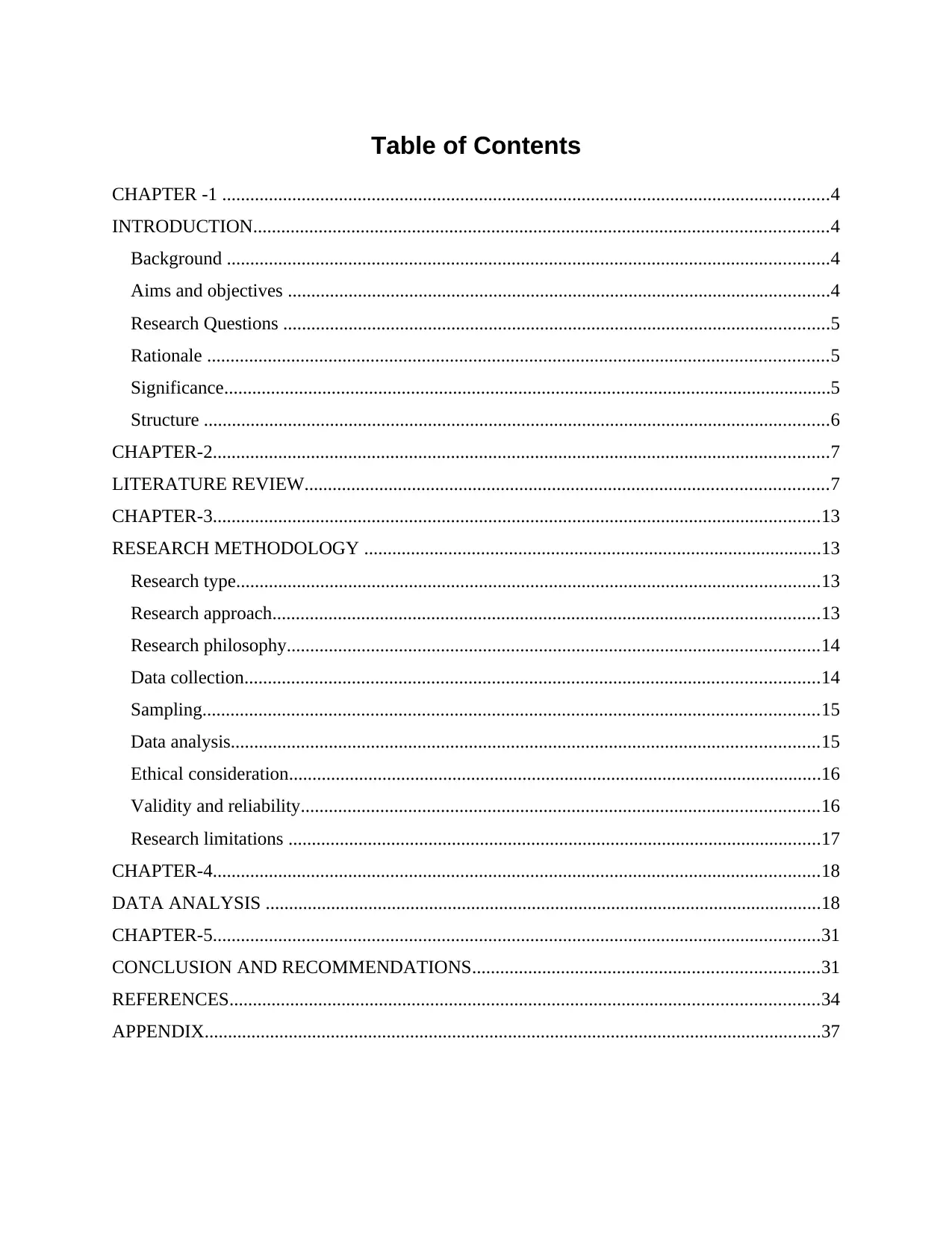
Table of Contents
CHAPTER -1 ..................................................................................................................................4
INTRODUCTION...........................................................................................................................4
Background .................................................................................................................................4
Aims and objectives ....................................................................................................................4
Research Questions .....................................................................................................................5
Rationale .....................................................................................................................................5
Significance..................................................................................................................................5
Structure ......................................................................................................................................6
CHAPTER-2....................................................................................................................................7
LITERATURE REVIEW................................................................................................................7
CHAPTER-3..................................................................................................................................13
RESEARCH METHODOLOGY ..................................................................................................13
Research type.............................................................................................................................13
Research approach.....................................................................................................................13
Research philosophy..................................................................................................................14
Data collection...........................................................................................................................14
Sampling....................................................................................................................................15
Data analysis..............................................................................................................................15
Ethical consideration..................................................................................................................16
Validity and reliability...............................................................................................................16
Research limitations ..................................................................................................................17
CHAPTER-4..................................................................................................................................18
DATA ANALYSIS .......................................................................................................................18
CHAPTER-5..................................................................................................................................31
CONCLUSION AND RECOMMENDATIONS..........................................................................31
REFERENCES..............................................................................................................................34
APPENDIX....................................................................................................................................37
CHAPTER -1 ..................................................................................................................................4
INTRODUCTION...........................................................................................................................4
Background .................................................................................................................................4
Aims and objectives ....................................................................................................................4
Research Questions .....................................................................................................................5
Rationale .....................................................................................................................................5
Significance..................................................................................................................................5
Structure ......................................................................................................................................6
CHAPTER-2....................................................................................................................................7
LITERATURE REVIEW................................................................................................................7
CHAPTER-3..................................................................................................................................13
RESEARCH METHODOLOGY ..................................................................................................13
Research type.............................................................................................................................13
Research approach.....................................................................................................................13
Research philosophy..................................................................................................................14
Data collection...........................................................................................................................14
Sampling....................................................................................................................................15
Data analysis..............................................................................................................................15
Ethical consideration..................................................................................................................16
Validity and reliability...............................................................................................................16
Research limitations ..................................................................................................................17
CHAPTER-4..................................................................................................................................18
DATA ANALYSIS .......................................................................................................................18
CHAPTER-5..................................................................................................................................31
CONCLUSION AND RECOMMENDATIONS..........................................................................31
REFERENCES..............................................................................................................................34
APPENDIX....................................................................................................................................37

⊘ This is a preview!⊘
Do you want full access?
Subscribe today to unlock all pages.

Trusted by 1+ million students worldwide
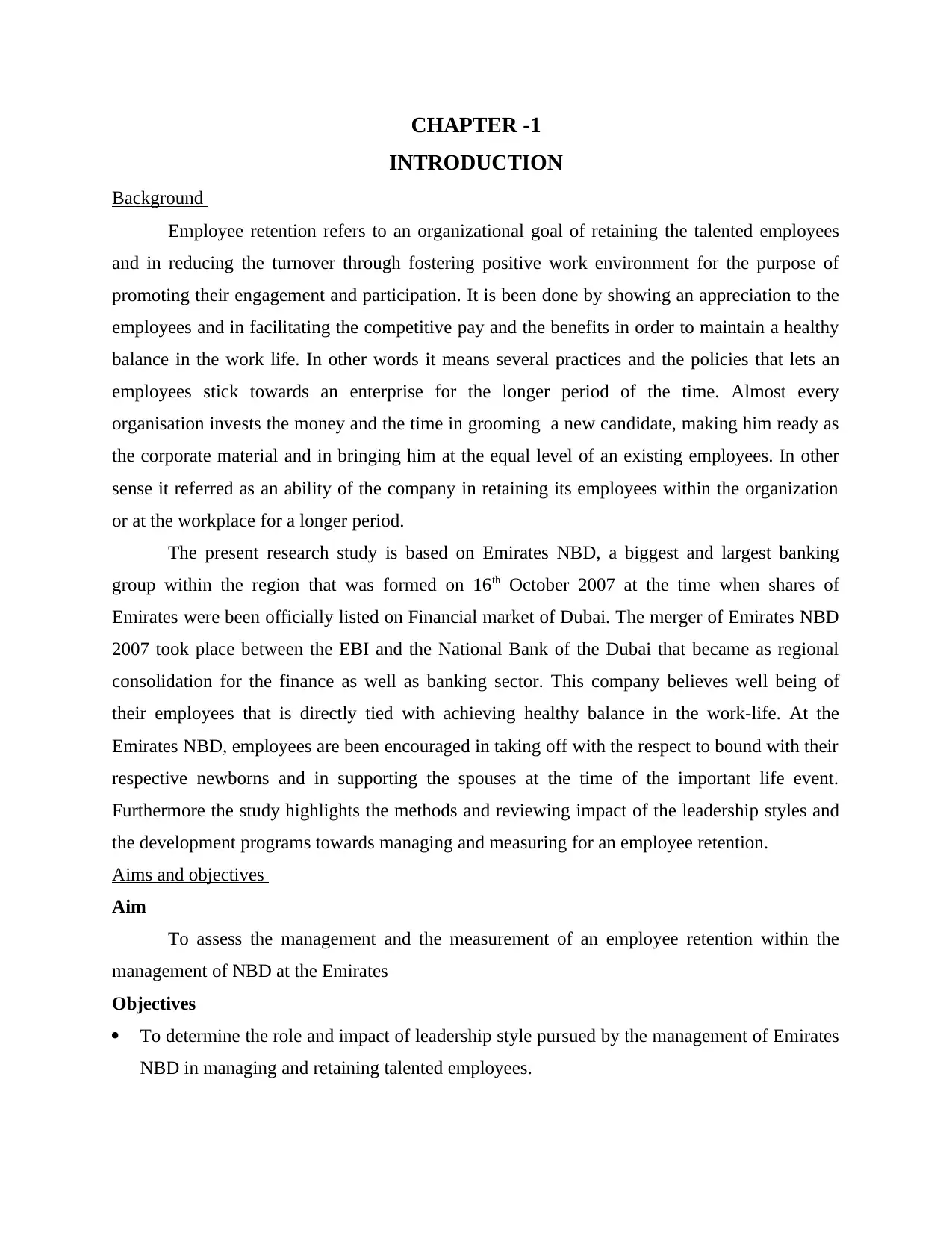
CHAPTER -1
INTRODUCTION
Background
Employee retention refers to an organizational goal of retaining the talented employees
and in reducing the turnover through fostering positive work environment for the purpose of
promoting their engagement and participation. It is been done by showing an appreciation to the
employees and in facilitating the competitive pay and the benefits in order to maintain a healthy
balance in the work life. In other words it means several practices and the policies that lets an
employees stick towards an enterprise for the longer period of the time. Almost every
organisation invests the money and the time in grooming a new candidate, making him ready as
the corporate material and in bringing him at the equal level of an existing employees. In other
sense it referred as an ability of the company in retaining its employees within the organization
or at the workplace for a longer period.
The present research study is based on Emirates NBD, a biggest and largest banking
group within the region that was formed on 16th October 2007 at the time when shares of
Emirates were been officially listed on Financial market of Dubai. The merger of Emirates NBD
2007 took place between the EBI and the National Bank of the Dubai that became as regional
consolidation for the finance as well as banking sector. This company believes well being of
their employees that is directly tied with achieving healthy balance in the work-life. At the
Emirates NBD, employees are been encouraged in taking off with the respect to bound with their
respective newborns and in supporting the spouses at the time of the important life event.
Furthermore the study highlights the methods and reviewing impact of the leadership styles and
the development programs towards managing and measuring for an employee retention.
Aims and objectives
Aim
To assess the management and the measurement of an employee retention within the
management of NBD at the Emirates
Objectives
To determine the role and impact of leadership style pursued by the management of Emirates
NBD in managing and retaining talented employees.
INTRODUCTION
Background
Employee retention refers to an organizational goal of retaining the talented employees
and in reducing the turnover through fostering positive work environment for the purpose of
promoting their engagement and participation. It is been done by showing an appreciation to the
employees and in facilitating the competitive pay and the benefits in order to maintain a healthy
balance in the work life. In other words it means several practices and the policies that lets an
employees stick towards an enterprise for the longer period of the time. Almost every
organisation invests the money and the time in grooming a new candidate, making him ready as
the corporate material and in bringing him at the equal level of an existing employees. In other
sense it referred as an ability of the company in retaining its employees within the organization
or at the workplace for a longer period.
The present research study is based on Emirates NBD, a biggest and largest banking
group within the region that was formed on 16th October 2007 at the time when shares of
Emirates were been officially listed on Financial market of Dubai. The merger of Emirates NBD
2007 took place between the EBI and the National Bank of the Dubai that became as regional
consolidation for the finance as well as banking sector. This company believes well being of
their employees that is directly tied with achieving healthy balance in the work-life. At the
Emirates NBD, employees are been encouraged in taking off with the respect to bound with their
respective newborns and in supporting the spouses at the time of the important life event.
Furthermore the study highlights the methods and reviewing impact of the leadership styles and
the development programs towards managing and measuring for an employee retention.
Aims and objectives
Aim
To assess the management and the measurement of an employee retention within the
management of NBD at the Emirates
Objectives
To determine the role and impact of leadership style pursued by the management of Emirates
NBD in managing and retaining talented employees.
Paraphrase This Document
Need a fresh take? Get an instant paraphrase of this document with our AI Paraphraser
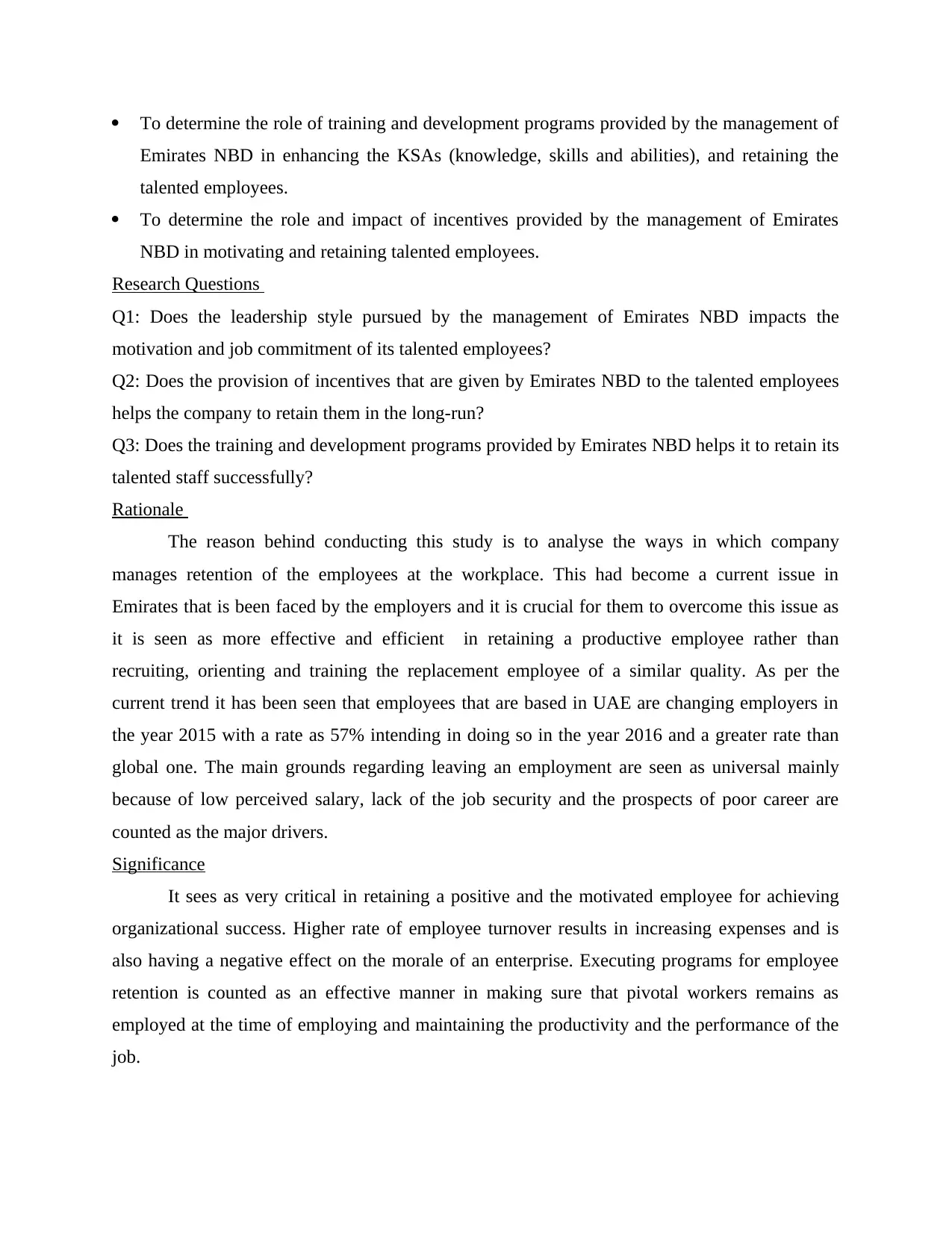
To determine the role of training and development programs provided by the management of
Emirates NBD in enhancing the KSAs (knowledge, skills and abilities), and retaining the
talented employees.
To determine the role and impact of incentives provided by the management of Emirates
NBD in motivating and retaining talented employees.
Research Questions
Q1: Does the leadership style pursued by the management of Emirates NBD impacts the
motivation and job commitment of its talented employees?
Q2: Does the provision of incentives that are given by Emirates NBD to the talented employees
helps the company to retain them in the long-run?
Q3: Does the training and development programs provided by Emirates NBD helps it to retain its
talented staff successfully?
Rationale
The reason behind conducting this study is to analyse the ways in which company
manages retention of the employees at the workplace. This had become a current issue in
Emirates that is been faced by the employers and it is crucial for them to overcome this issue as
it is seen as more effective and efficient in retaining a productive employee rather than
recruiting, orienting and training the replacement employee of a similar quality. As per the
current trend it has been seen that employees that are based in UAE are changing employers in
the year 2015 with a rate as 57% intending in doing so in the year 2016 and a greater rate than
global one. The main grounds regarding leaving an employment are seen as universal mainly
because of low perceived salary, lack of the job security and the prospects of poor career are
counted as the major drivers.
Significance
It sees as very critical in retaining a positive and the motivated employee for achieving
organizational success. Higher rate of employee turnover results in increasing expenses and is
also having a negative effect on the morale of an enterprise. Executing programs for employee
retention is counted as an effective manner in making sure that pivotal workers remains as
employed at the time of employing and maintaining the productivity and the performance of the
job.
Emirates NBD in enhancing the KSAs (knowledge, skills and abilities), and retaining the
talented employees.
To determine the role and impact of incentives provided by the management of Emirates
NBD in motivating and retaining talented employees.
Research Questions
Q1: Does the leadership style pursued by the management of Emirates NBD impacts the
motivation and job commitment of its talented employees?
Q2: Does the provision of incentives that are given by Emirates NBD to the talented employees
helps the company to retain them in the long-run?
Q3: Does the training and development programs provided by Emirates NBD helps it to retain its
talented staff successfully?
Rationale
The reason behind conducting this study is to analyse the ways in which company
manages retention of the employees at the workplace. This had become a current issue in
Emirates that is been faced by the employers and it is crucial for them to overcome this issue as
it is seen as more effective and efficient in retaining a productive employee rather than
recruiting, orienting and training the replacement employee of a similar quality. As per the
current trend it has been seen that employees that are based in UAE are changing employers in
the year 2015 with a rate as 57% intending in doing so in the year 2016 and a greater rate than
global one. The main grounds regarding leaving an employment are seen as universal mainly
because of low perceived salary, lack of the job security and the prospects of poor career are
counted as the major drivers.
Significance
It sees as very critical in retaining a positive and the motivated employee for achieving
organizational success. Higher rate of employee turnover results in increasing expenses and is
also having a negative effect on the morale of an enterprise. Executing programs for employee
retention is counted as an effective manner in making sure that pivotal workers remains as
employed at the time of employing and maintaining the productivity and the performance of the
job.
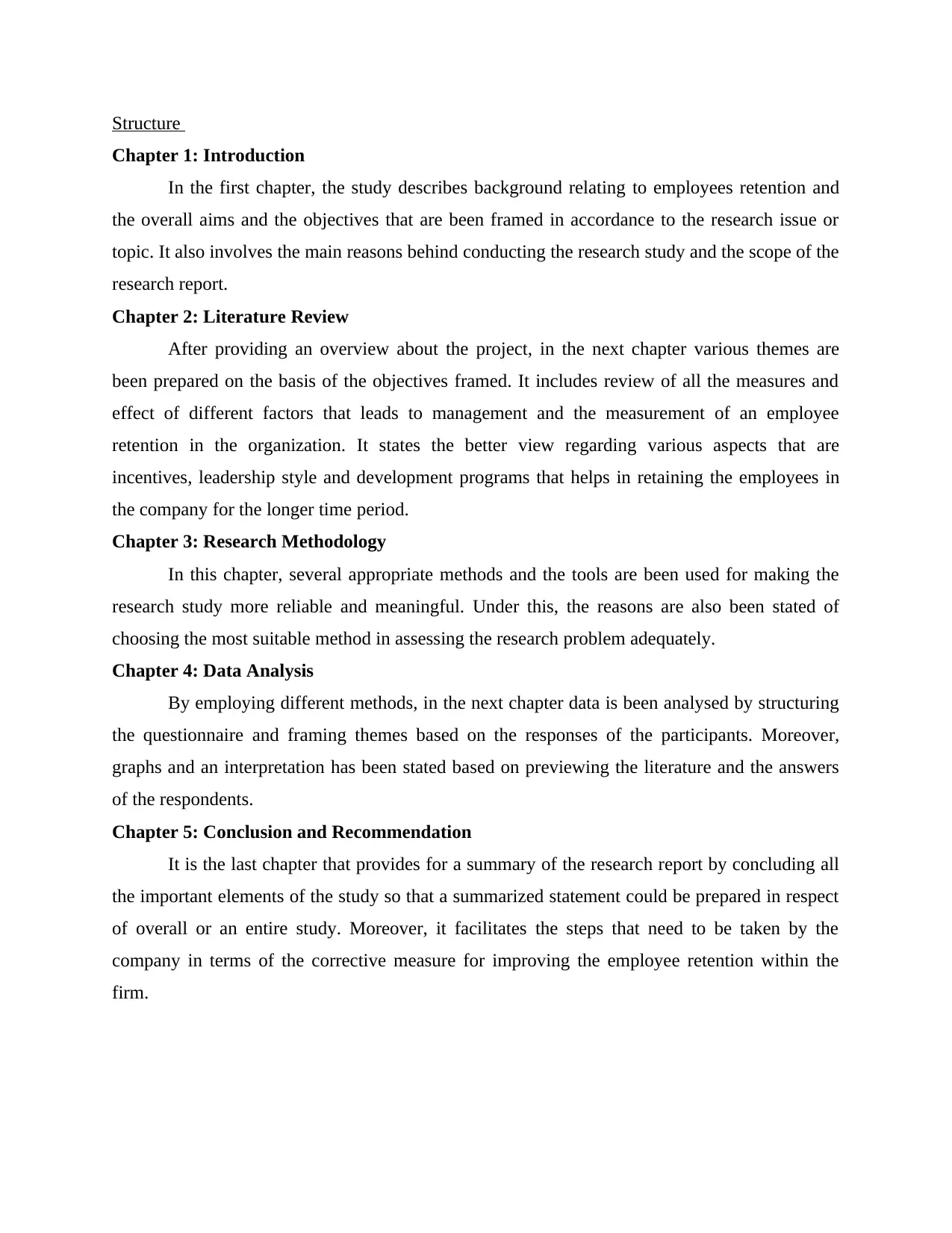
Structure
Chapter 1: Introduction
In the first chapter, the study describes background relating to employees retention and
the overall aims and the objectives that are been framed in accordance to the research issue or
topic. It also involves the main reasons behind conducting the research study and the scope of the
research report.
Chapter 2: Literature Review
After providing an overview about the project, in the next chapter various themes are
been prepared on the basis of the objectives framed. It includes review of all the measures and
effect of different factors that leads to management and the measurement of an employee
retention in the organization. It states the better view regarding various aspects that are
incentives, leadership style and development programs that helps in retaining the employees in
the company for the longer time period.
Chapter 3: Research Methodology
In this chapter, several appropriate methods and the tools are been used for making the
research study more reliable and meaningful. Under this, the reasons are also been stated of
choosing the most suitable method in assessing the research problem adequately.
Chapter 4: Data Analysis
By employing different methods, in the next chapter data is been analysed by structuring
the questionnaire and framing themes based on the responses of the participants. Moreover,
graphs and an interpretation has been stated based on previewing the literature and the answers
of the respondents.
Chapter 5: Conclusion and Recommendation
It is the last chapter that provides for a summary of the research report by concluding all
the important elements of the study so that a summarized statement could be prepared in respect
of overall or an entire study. Moreover, it facilitates the steps that need to be taken by the
company in terms of the corrective measure for improving the employee retention within the
firm.
Chapter 1: Introduction
In the first chapter, the study describes background relating to employees retention and
the overall aims and the objectives that are been framed in accordance to the research issue or
topic. It also involves the main reasons behind conducting the research study and the scope of the
research report.
Chapter 2: Literature Review
After providing an overview about the project, in the next chapter various themes are
been prepared on the basis of the objectives framed. It includes review of all the measures and
effect of different factors that leads to management and the measurement of an employee
retention in the organization. It states the better view regarding various aspects that are
incentives, leadership style and development programs that helps in retaining the employees in
the company for the longer time period.
Chapter 3: Research Methodology
In this chapter, several appropriate methods and the tools are been used for making the
research study more reliable and meaningful. Under this, the reasons are also been stated of
choosing the most suitable method in assessing the research problem adequately.
Chapter 4: Data Analysis
By employing different methods, in the next chapter data is been analysed by structuring
the questionnaire and framing themes based on the responses of the participants. Moreover,
graphs and an interpretation has been stated based on previewing the literature and the answers
of the respondents.
Chapter 5: Conclusion and Recommendation
It is the last chapter that provides for a summary of the research report by concluding all
the important elements of the study so that a summarized statement could be prepared in respect
of overall or an entire study. Moreover, it facilitates the steps that need to be taken by the
company in terms of the corrective measure for improving the employee retention within the
firm.
⊘ This is a preview!⊘
Do you want full access?
Subscribe today to unlock all pages.

Trusted by 1+ million students worldwide
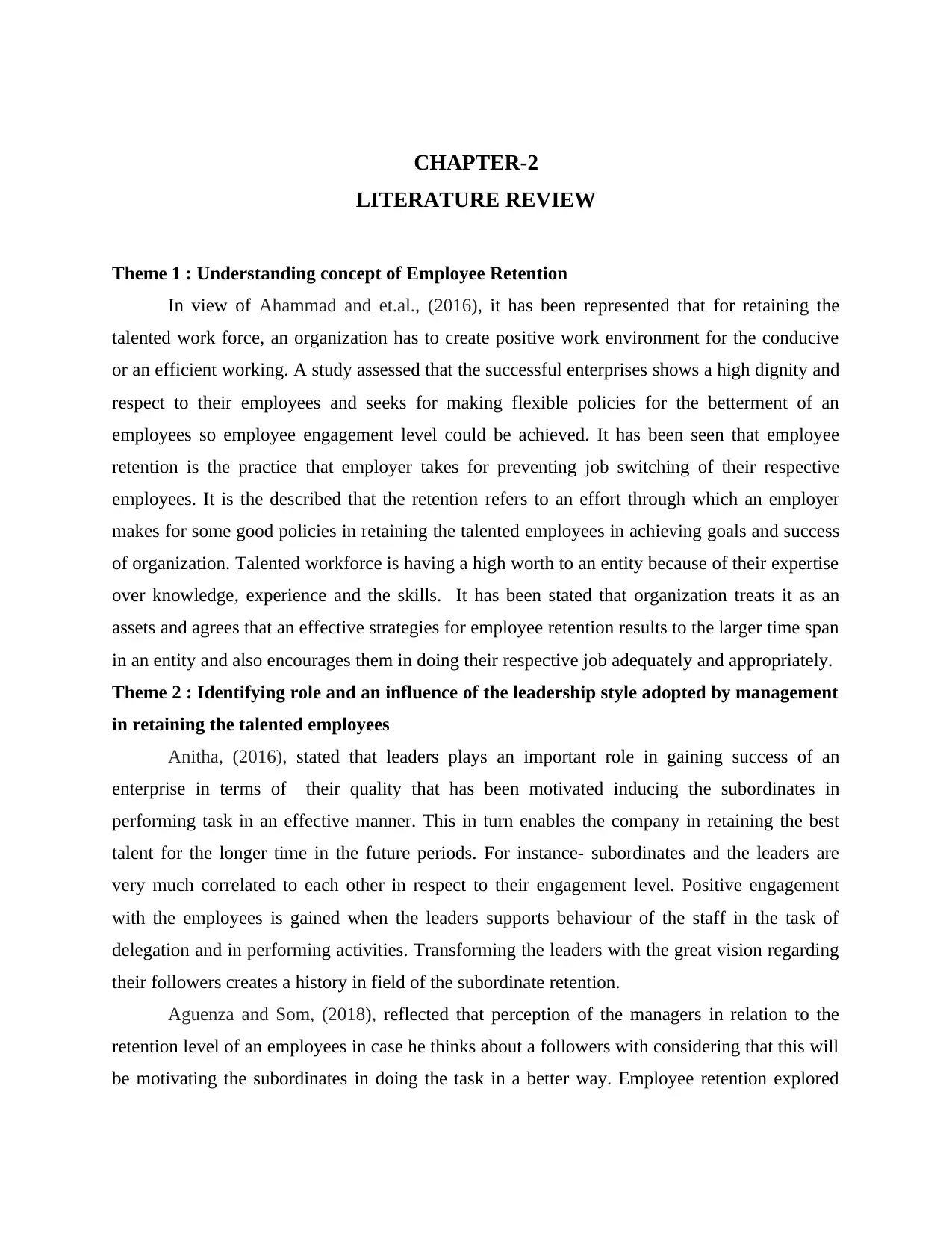
CHAPTER-2
LITERATURE REVIEW
Theme 1 : Understanding concept of Employee Retention
In view of Ahammad and et.al., (2016), it has been represented that for retaining the
talented work force, an organization has to create positive work environment for the conducive
or an efficient working. A study assessed that the successful enterprises shows a high dignity and
respect to their employees and seeks for making flexible policies for the betterment of an
employees so employee engagement level could be achieved. It has been seen that employee
retention is the practice that employer takes for preventing job switching of their respective
employees. It is the described that the retention refers to an effort through which an employer
makes for some good policies in retaining the talented employees in achieving goals and success
of organization. Talented workforce is having a high worth to an entity because of their expertise
over knowledge, experience and the skills. It has been stated that organization treats it as an
assets and agrees that an effective strategies for employee retention results to the larger time span
in an entity and also encourages them in doing their respective job adequately and appropriately.
Theme 2 : Identifying role and an influence of the leadership style adopted by management
in retaining the talented employees
Anitha, (2016), stated that leaders plays an important role in gaining success of an
enterprise in terms of their quality that has been motivated inducing the subordinates in
performing task in an effective manner. This in turn enables the company in retaining the best
talent for the longer time in the future periods. For instance- subordinates and the leaders are
very much correlated to each other in respect to their engagement level. Positive engagement
with the employees is gained when the leaders supports behaviour of the staff in the task of
delegation and in performing activities. Transforming the leaders with the great vision regarding
their followers creates a history in field of the subordinate retention.
Aguenza and Som, (2018), reflected that perception of the managers in relation to the
retention level of an employees in case he thinks about a followers with considering that this will
be motivating the subordinates in doing the task in a better way. Employee retention explored
LITERATURE REVIEW
Theme 1 : Understanding concept of Employee Retention
In view of Ahammad and et.al., (2016), it has been represented that for retaining the
talented work force, an organization has to create positive work environment for the conducive
or an efficient working. A study assessed that the successful enterprises shows a high dignity and
respect to their employees and seeks for making flexible policies for the betterment of an
employees so employee engagement level could be achieved. It has been seen that employee
retention is the practice that employer takes for preventing job switching of their respective
employees. It is the described that the retention refers to an effort through which an employer
makes for some good policies in retaining the talented employees in achieving goals and success
of organization. Talented workforce is having a high worth to an entity because of their expertise
over knowledge, experience and the skills. It has been stated that organization treats it as an
assets and agrees that an effective strategies for employee retention results to the larger time span
in an entity and also encourages them in doing their respective job adequately and appropriately.
Theme 2 : Identifying role and an influence of the leadership style adopted by management
in retaining the talented employees
Anitha, (2016), stated that leaders plays an important role in gaining success of an
enterprise in terms of their quality that has been motivated inducing the subordinates in
performing task in an effective manner. This in turn enables the company in retaining the best
talent for the longer time in the future periods. For instance- subordinates and the leaders are
very much correlated to each other in respect to their engagement level. Positive engagement
with the employees is gained when the leaders supports behaviour of the staff in the task of
delegation and in performing activities. Transforming the leaders with the great vision regarding
their followers creates a history in field of the subordinate retention.
Aguenza and Som, (2018), reflected that perception of the managers in relation to the
retention level of an employees in case he thinks about a followers with considering that this will
be motivating the subordinates in doing the task in a better way. Employee retention explored
Paraphrase This Document
Need a fresh take? Get an instant paraphrase of this document with our AI Paraphraser
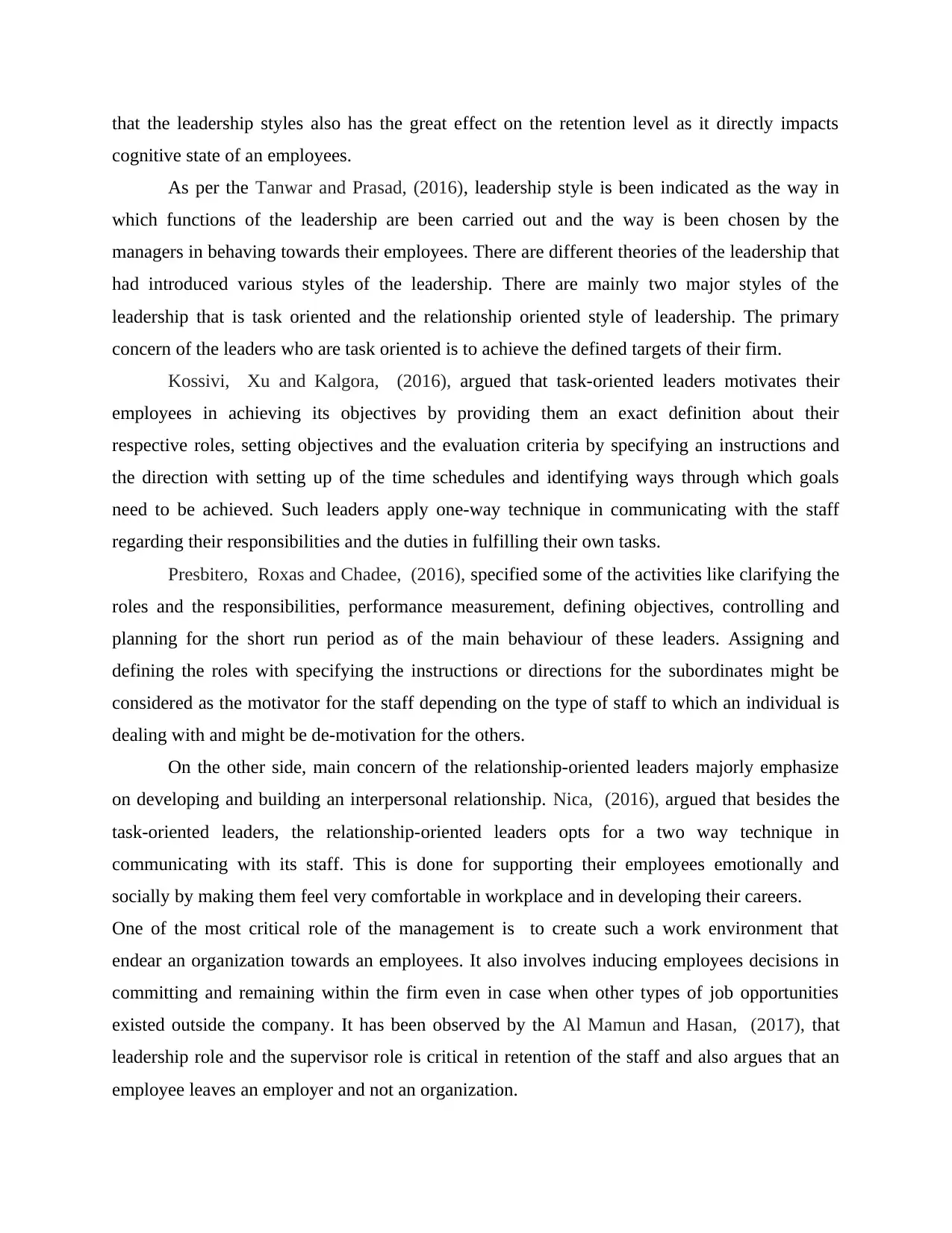
that the leadership styles also has the great effect on the retention level as it directly impacts
cognitive state of an employees.
As per the Tanwar and Prasad, (2016), leadership style is been indicated as the way in
which functions of the leadership are been carried out and the way is been chosen by the
managers in behaving towards their employees. There are different theories of the leadership that
had introduced various styles of the leadership. There are mainly two major styles of the
leadership that is task oriented and the relationship oriented style of leadership. The primary
concern of the leaders who are task oriented is to achieve the defined targets of their firm.
Kossivi, Xu and Kalgora, (2016), argued that task-oriented leaders motivates their
employees in achieving its objectives by providing them an exact definition about their
respective roles, setting objectives and the evaluation criteria by specifying an instructions and
the direction with setting up of the time schedules and identifying ways through which goals
need to be achieved. Such leaders apply one-way technique in communicating with the staff
regarding their responsibilities and the duties in fulfilling their own tasks.
Presbitero, Roxas and Chadee, (2016), specified some of the activities like clarifying the
roles and the responsibilities, performance measurement, defining objectives, controlling and
planning for the short run period as of the main behaviour of these leaders. Assigning and
defining the roles with specifying the instructions or directions for the subordinates might be
considered as the motivator for the staff depending on the type of staff to which an individual is
dealing with and might be de-motivation for the others.
On the other side, main concern of the relationship-oriented leaders majorly emphasize
on developing and building an interpersonal relationship. Nica, (2016), argued that besides the
task-oriented leaders, the relationship-oriented leaders opts for a two way technique in
communicating with its staff. This is done for supporting their employees emotionally and
socially by making them feel very comfortable in workplace and in developing their careers.
One of the most critical role of the management is to create such a work environment that
endear an organization towards an employees. It also involves inducing employees decisions in
committing and remaining within the firm even in case when other types of job opportunities
existed outside the company. It has been observed by the Al Mamun and Hasan, (2017), that
leadership role and the supervisor role is critical in retention of the staff and also argues that an
employee leaves an employer and not an organization.
cognitive state of an employees.
As per the Tanwar and Prasad, (2016), leadership style is been indicated as the way in
which functions of the leadership are been carried out and the way is been chosen by the
managers in behaving towards their employees. There are different theories of the leadership that
had introduced various styles of the leadership. There are mainly two major styles of the
leadership that is task oriented and the relationship oriented style of leadership. The primary
concern of the leaders who are task oriented is to achieve the defined targets of their firm.
Kossivi, Xu and Kalgora, (2016), argued that task-oriented leaders motivates their
employees in achieving its objectives by providing them an exact definition about their
respective roles, setting objectives and the evaluation criteria by specifying an instructions and
the direction with setting up of the time schedules and identifying ways through which goals
need to be achieved. Such leaders apply one-way technique in communicating with the staff
regarding their responsibilities and the duties in fulfilling their own tasks.
Presbitero, Roxas and Chadee, (2016), specified some of the activities like clarifying the
roles and the responsibilities, performance measurement, defining objectives, controlling and
planning for the short run period as of the main behaviour of these leaders. Assigning and
defining the roles with specifying the instructions or directions for the subordinates might be
considered as the motivator for the staff depending on the type of staff to which an individual is
dealing with and might be de-motivation for the others.
On the other side, main concern of the relationship-oriented leaders majorly emphasize
on developing and building an interpersonal relationship. Nica, (2016), argued that besides the
task-oriented leaders, the relationship-oriented leaders opts for a two way technique in
communicating with its staff. This is done for supporting their employees emotionally and
socially by making them feel very comfortable in workplace and in developing their careers.
One of the most critical role of the management is to create such a work environment that
endear an organization towards an employees. It also involves inducing employees decisions in
committing and remaining within the firm even in case when other types of job opportunities
existed outside the company. It has been observed by the Al Mamun and Hasan, (2017), that
leadership role and the supervisor role is critical in retention of the staff and also argues that an
employee leaves an employer and not an organization.
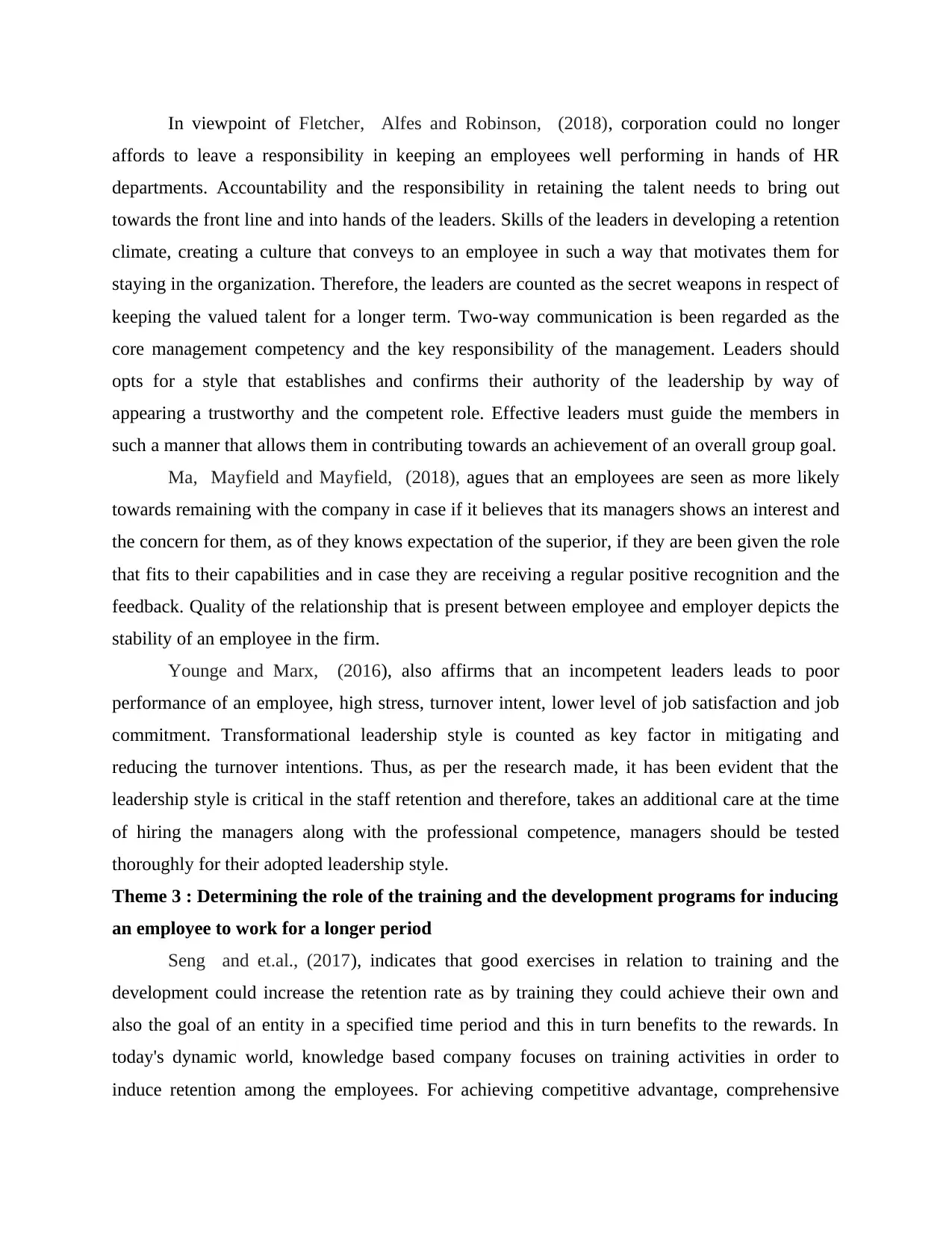
In viewpoint of Fletcher, Alfes and Robinson, (2018), corporation could no longer
affords to leave a responsibility in keeping an employees well performing in hands of HR
departments. Accountability and the responsibility in retaining the talent needs to bring out
towards the front line and into hands of the leaders. Skills of the leaders in developing a retention
climate, creating a culture that conveys to an employee in such a way that motivates them for
staying in the organization. Therefore, the leaders are counted as the secret weapons in respect of
keeping the valued talent for a longer term. Two-way communication is been regarded as the
core management competency and the key responsibility of the management. Leaders should
opts for a style that establishes and confirms their authority of the leadership by way of
appearing a trustworthy and the competent role. Effective leaders must guide the members in
such a manner that allows them in contributing towards an achievement of an overall group goal.
Ma, Mayfield and Mayfield, (2018), agues that an employees are seen as more likely
towards remaining with the company in case if it believes that its managers shows an interest and
the concern for them, as of they knows expectation of the superior, if they are been given the role
that fits to their capabilities and in case they are receiving a regular positive recognition and the
feedback. Quality of the relationship that is present between employee and employer depicts the
stability of an employee in the firm.
Younge and Marx, (2016), also affirms that an incompetent leaders leads to poor
performance of an employee, high stress, turnover intent, lower level of job satisfaction and job
commitment. Transformational leadership style is counted as key factor in mitigating and
reducing the turnover intentions. Thus, as per the research made, it has been evident that the
leadership style is critical in the staff retention and therefore, takes an additional care at the time
of hiring the managers along with the professional competence, managers should be tested
thoroughly for their adopted leadership style.
Theme 3 : Determining the role of the training and the development programs for inducing
an employee to work for a longer period
Seng and et.al., (2017), indicates that good exercises in relation to training and the
development could increase the retention rate as by training they could achieve their own and
also the goal of an entity in a specified time period and this in turn benefits to the rewards. In
today's dynamic world, knowledge based company focuses on training activities in order to
induce retention among the employees. For achieving competitive advantage, comprehensive
affords to leave a responsibility in keeping an employees well performing in hands of HR
departments. Accountability and the responsibility in retaining the talent needs to bring out
towards the front line and into hands of the leaders. Skills of the leaders in developing a retention
climate, creating a culture that conveys to an employee in such a way that motivates them for
staying in the organization. Therefore, the leaders are counted as the secret weapons in respect of
keeping the valued talent for a longer term. Two-way communication is been regarded as the
core management competency and the key responsibility of the management. Leaders should
opts for a style that establishes and confirms their authority of the leadership by way of
appearing a trustworthy and the competent role. Effective leaders must guide the members in
such a manner that allows them in contributing towards an achievement of an overall group goal.
Ma, Mayfield and Mayfield, (2018), agues that an employees are seen as more likely
towards remaining with the company in case if it believes that its managers shows an interest and
the concern for them, as of they knows expectation of the superior, if they are been given the role
that fits to their capabilities and in case they are receiving a regular positive recognition and the
feedback. Quality of the relationship that is present between employee and employer depicts the
stability of an employee in the firm.
Younge and Marx, (2016), also affirms that an incompetent leaders leads to poor
performance of an employee, high stress, turnover intent, lower level of job satisfaction and job
commitment. Transformational leadership style is counted as key factor in mitigating and
reducing the turnover intentions. Thus, as per the research made, it has been evident that the
leadership style is critical in the staff retention and therefore, takes an additional care at the time
of hiring the managers along with the professional competence, managers should be tested
thoroughly for their adopted leadership style.
Theme 3 : Determining the role of the training and the development programs for inducing
an employee to work for a longer period
Seng and et.al., (2017), indicates that good exercises in relation to training and the
development could increase the retention rate as by training they could achieve their own and
also the goal of an entity in a specified time period and this in turn benefits to the rewards. In
today's dynamic world, knowledge based company focuses on training activities in order to
induce retention among the employees. For achieving competitive advantage, comprehensive
⊘ This is a preview!⊘
Do you want full access?
Subscribe today to unlock all pages.

Trusted by 1+ million students worldwide
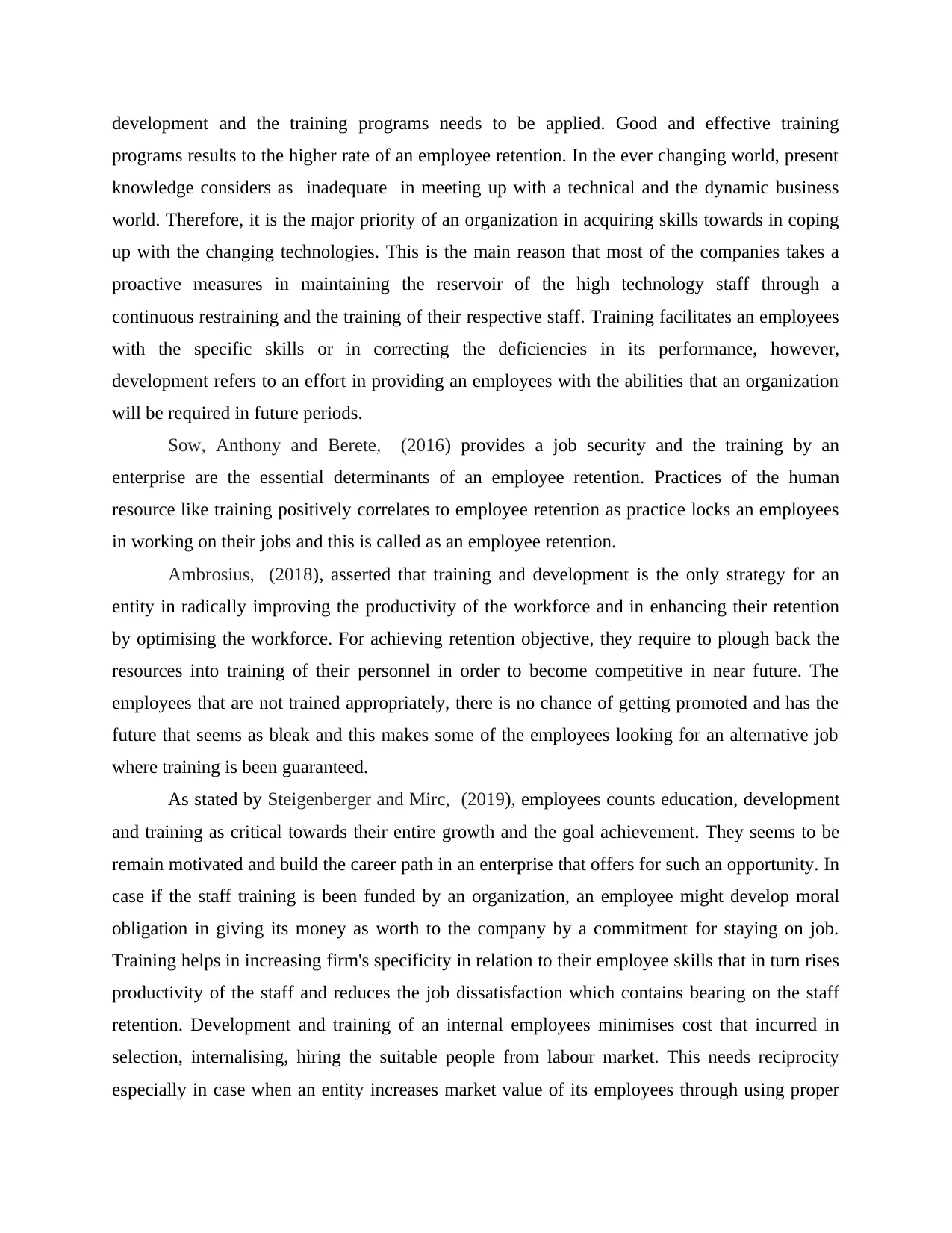
development and the training programs needs to be applied. Good and effective training
programs results to the higher rate of an employee retention. In the ever changing world, present
knowledge considers as inadequate in meeting up with a technical and the dynamic business
world. Therefore, it is the major priority of an organization in acquiring skills towards in coping
up with the changing technologies. This is the main reason that most of the companies takes a
proactive measures in maintaining the reservoir of the high technology staff through a
continuous restraining and the training of their respective staff. Training facilitates an employees
with the specific skills or in correcting the deficiencies in its performance, however,
development refers to an effort in providing an employees with the abilities that an organization
will be required in future periods.
Sow, Anthony and Berete, (2016) provides a job security and the training by an
enterprise are the essential determinants of an employee retention. Practices of the human
resource like training positively correlates to employee retention as practice locks an employees
in working on their jobs and this is called as an employee retention.
Ambrosius, (2018), asserted that training and development is the only strategy for an
entity in radically improving the productivity of the workforce and in enhancing their retention
by optimising the workforce. For achieving retention objective, they require to plough back the
resources into training of their personnel in order to become competitive in near future. The
employees that are not trained appropriately, there is no chance of getting promoted and has the
future that seems as bleak and this makes some of the employees looking for an alternative job
where training is been guaranteed.
As stated by Steigenberger and Mirc, (2019), employees counts education, development
and training as critical towards their entire growth and the goal achievement. They seems to be
remain motivated and build the career path in an enterprise that offers for such an opportunity. In
case if the staff training is been funded by an organization, an employee might develop moral
obligation in giving its money as worth to the company by a commitment for staying on job.
Training helps in increasing firm's specificity in relation to their employee skills that in turn rises
productivity of the staff and reduces the job dissatisfaction which contains bearing on the staff
retention. Development and training of an internal employees minimises cost that incurred in
selection, internalising, hiring the suitable people from labour market. This needs reciprocity
especially in case when an entity increases market value of its employees through using proper
programs results to the higher rate of an employee retention. In the ever changing world, present
knowledge considers as inadequate in meeting up with a technical and the dynamic business
world. Therefore, it is the major priority of an organization in acquiring skills towards in coping
up with the changing technologies. This is the main reason that most of the companies takes a
proactive measures in maintaining the reservoir of the high technology staff through a
continuous restraining and the training of their respective staff. Training facilitates an employees
with the specific skills or in correcting the deficiencies in its performance, however,
development refers to an effort in providing an employees with the abilities that an organization
will be required in future periods.
Sow, Anthony and Berete, (2016) provides a job security and the training by an
enterprise are the essential determinants of an employee retention. Practices of the human
resource like training positively correlates to employee retention as practice locks an employees
in working on their jobs and this is called as an employee retention.
Ambrosius, (2018), asserted that training and development is the only strategy for an
entity in radically improving the productivity of the workforce and in enhancing their retention
by optimising the workforce. For achieving retention objective, they require to plough back the
resources into training of their personnel in order to become competitive in near future. The
employees that are not trained appropriately, there is no chance of getting promoted and has the
future that seems as bleak and this makes some of the employees looking for an alternative job
where training is been guaranteed.
As stated by Steigenberger and Mirc, (2019), employees counts education, development
and training as critical towards their entire growth and the goal achievement. They seems to be
remain motivated and build the career path in an enterprise that offers for such an opportunity. In
case if the staff training is been funded by an organization, an employee might develop moral
obligation in giving its money as worth to the company by a commitment for staying on job.
Training helps in increasing firm's specificity in relation to their employee skills that in turn rises
productivity of the staff and reduces the job dissatisfaction which contains bearing on the staff
retention. Development and training of an internal employees minimises cost that incurred in
selection, internalising, hiring the suitable people from labour market. This needs reciprocity
especially in case when an entity increases market value of its employees through using proper
Paraphrase This Document
Need a fresh take? Get an instant paraphrase of this document with our AI Paraphraser
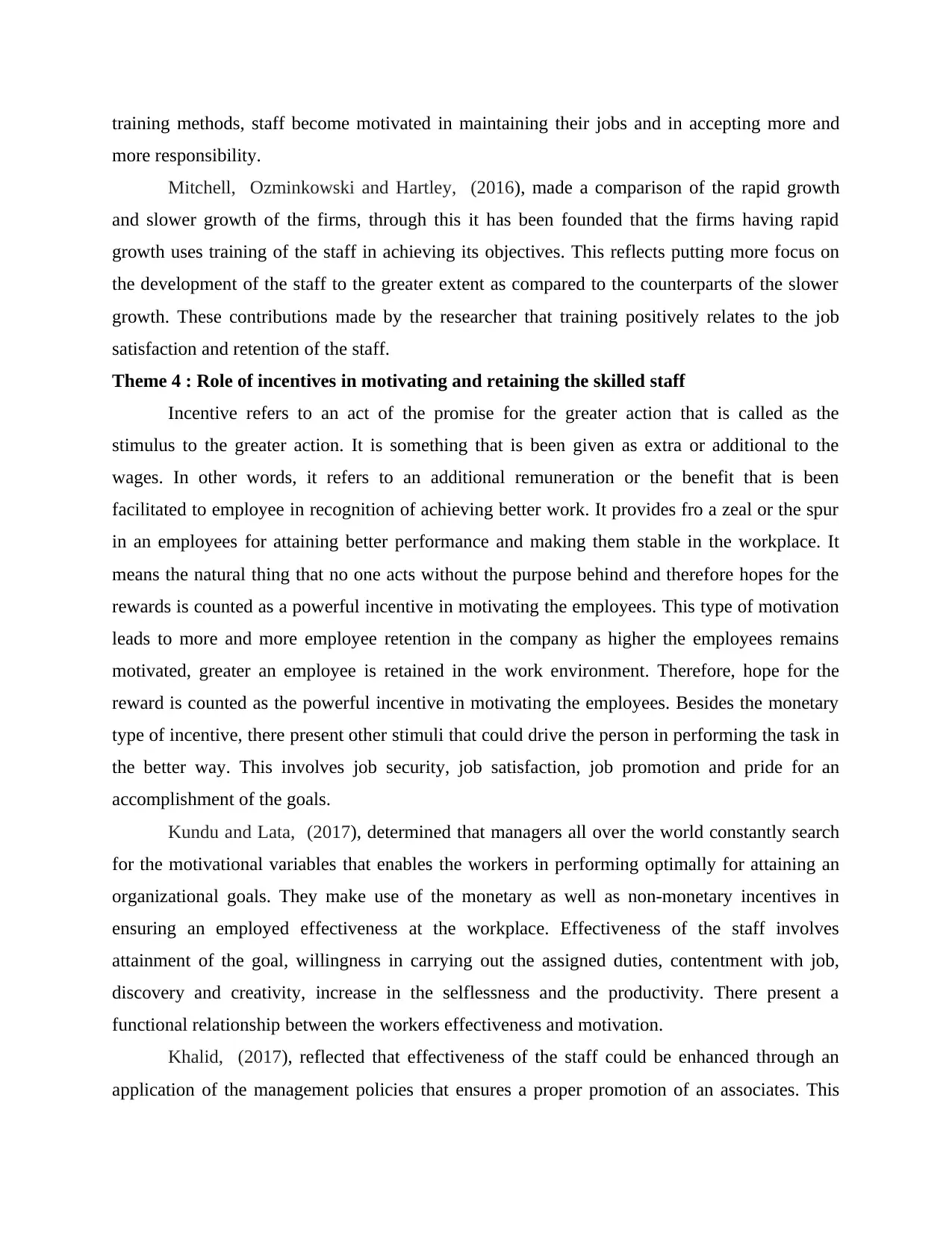
training methods, staff become motivated in maintaining their jobs and in accepting more and
more responsibility.
Mitchell, Ozminkowski and Hartley, (2016), made a comparison of the rapid growth
and slower growth of the firms, through this it has been founded that the firms having rapid
growth uses training of the staff in achieving its objectives. This reflects putting more focus on
the development of the staff to the greater extent as compared to the counterparts of the slower
growth. These contributions made by the researcher that training positively relates to the job
satisfaction and retention of the staff.
Theme 4 : Role of incentives in motivating and retaining the skilled staff
Incentive refers to an act of the promise for the greater action that is called as the
stimulus to the greater action. It is something that is been given as extra or additional to the
wages. In other words, it refers to an additional remuneration or the benefit that is been
facilitated to employee in recognition of achieving better work. It provides fro a zeal or the spur
in an employees for attaining better performance and making them stable in the workplace. It
means the natural thing that no one acts without the purpose behind and therefore hopes for the
rewards is counted as a powerful incentive in motivating the employees. This type of motivation
leads to more and more employee retention in the company as higher the employees remains
motivated, greater an employee is retained in the work environment. Therefore, hope for the
reward is counted as the powerful incentive in motivating the employees. Besides the monetary
type of incentive, there present other stimuli that could drive the person in performing the task in
the better way. This involves job security, job satisfaction, job promotion and pride for an
accomplishment of the goals.
Kundu and Lata, (2017), determined that managers all over the world constantly search
for the motivational variables that enables the workers in performing optimally for attaining an
organizational goals. They make use of the monetary as well as non-monetary incentives in
ensuring an employed effectiveness at the workplace. Effectiveness of the staff involves
attainment of the goal, willingness in carrying out the assigned duties, contentment with job,
discovery and creativity, increase in the selflessness and the productivity. There present a
functional relationship between the workers effectiveness and motivation.
Khalid, (2017), reflected that effectiveness of the staff could be enhanced through an
application of the management policies that ensures a proper promotion of an associates. This
more responsibility.
Mitchell, Ozminkowski and Hartley, (2016), made a comparison of the rapid growth
and slower growth of the firms, through this it has been founded that the firms having rapid
growth uses training of the staff in achieving its objectives. This reflects putting more focus on
the development of the staff to the greater extent as compared to the counterparts of the slower
growth. These contributions made by the researcher that training positively relates to the job
satisfaction and retention of the staff.
Theme 4 : Role of incentives in motivating and retaining the skilled staff
Incentive refers to an act of the promise for the greater action that is called as the
stimulus to the greater action. It is something that is been given as extra or additional to the
wages. In other words, it refers to an additional remuneration or the benefit that is been
facilitated to employee in recognition of achieving better work. It provides fro a zeal or the spur
in an employees for attaining better performance and making them stable in the workplace. It
means the natural thing that no one acts without the purpose behind and therefore hopes for the
rewards is counted as a powerful incentive in motivating the employees. This type of motivation
leads to more and more employee retention in the company as higher the employees remains
motivated, greater an employee is retained in the work environment. Therefore, hope for the
reward is counted as the powerful incentive in motivating the employees. Besides the monetary
type of incentive, there present other stimuli that could drive the person in performing the task in
the better way. This involves job security, job satisfaction, job promotion and pride for an
accomplishment of the goals.
Kundu and Lata, (2017), determined that managers all over the world constantly search
for the motivational variables that enables the workers in performing optimally for attaining an
organizational goals. They make use of the monetary as well as non-monetary incentives in
ensuring an employed effectiveness at the workplace. Effectiveness of the staff involves
attainment of the goal, willingness in carrying out the assigned duties, contentment with job,
discovery and creativity, increase in the selflessness and the productivity. There present a
functional relationship between the workers effectiveness and motivation.
Khalid, (2017), reflected that effectiveness of the staff could be enhanced through an
application of the management policies that ensures a proper promotion of an associates. This
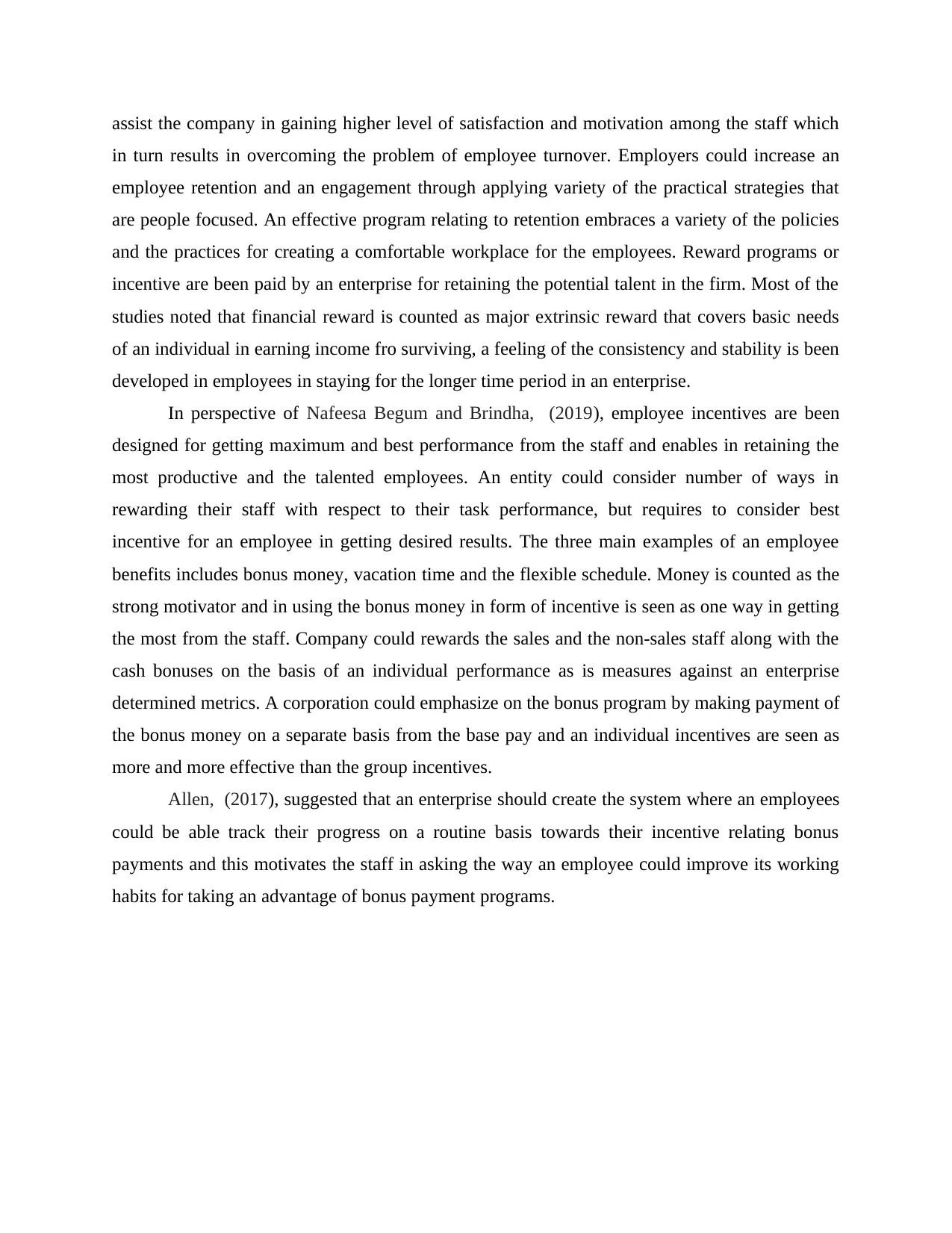
assist the company in gaining higher level of satisfaction and motivation among the staff which
in turn results in overcoming the problem of employee turnover. Employers could increase an
employee retention and an engagement through applying variety of the practical strategies that
are people focused. An effective program relating to retention embraces a variety of the policies
and the practices for creating a comfortable workplace for the employees. Reward programs or
incentive are been paid by an enterprise for retaining the potential talent in the firm. Most of the
studies noted that financial reward is counted as major extrinsic reward that covers basic needs
of an individual in earning income fro surviving, a feeling of the consistency and stability is been
developed in employees in staying for the longer time period in an enterprise.
In perspective of Nafeesa Begum and Brindha, (2019), employee incentives are been
designed for getting maximum and best performance from the staff and enables in retaining the
most productive and the talented employees. An entity could consider number of ways in
rewarding their staff with respect to their task performance, but requires to consider best
incentive for an employee in getting desired results. The three main examples of an employee
benefits includes bonus money, vacation time and the flexible schedule. Money is counted as the
strong motivator and in using the bonus money in form of incentive is seen as one way in getting
the most from the staff. Company could rewards the sales and the non-sales staff along with the
cash bonuses on the basis of an individual performance as is measures against an enterprise
determined metrics. A corporation could emphasize on the bonus program by making payment of
the bonus money on a separate basis from the base pay and an individual incentives are seen as
more and more effective than the group incentives.
Allen, (2017), suggested that an enterprise should create the system where an employees
could be able track their progress on a routine basis towards their incentive relating bonus
payments and this motivates the staff in asking the way an employee could improve its working
habits for taking an advantage of bonus payment programs.
in turn results in overcoming the problem of employee turnover. Employers could increase an
employee retention and an engagement through applying variety of the practical strategies that
are people focused. An effective program relating to retention embraces a variety of the policies
and the practices for creating a comfortable workplace for the employees. Reward programs or
incentive are been paid by an enterprise for retaining the potential talent in the firm. Most of the
studies noted that financial reward is counted as major extrinsic reward that covers basic needs
of an individual in earning income fro surviving, a feeling of the consistency and stability is been
developed in employees in staying for the longer time period in an enterprise.
In perspective of Nafeesa Begum and Brindha, (2019), employee incentives are been
designed for getting maximum and best performance from the staff and enables in retaining the
most productive and the talented employees. An entity could consider number of ways in
rewarding their staff with respect to their task performance, but requires to consider best
incentive for an employee in getting desired results. The three main examples of an employee
benefits includes bonus money, vacation time and the flexible schedule. Money is counted as the
strong motivator and in using the bonus money in form of incentive is seen as one way in getting
the most from the staff. Company could rewards the sales and the non-sales staff along with the
cash bonuses on the basis of an individual performance as is measures against an enterprise
determined metrics. A corporation could emphasize on the bonus program by making payment of
the bonus money on a separate basis from the base pay and an individual incentives are seen as
more and more effective than the group incentives.
Allen, (2017), suggested that an enterprise should create the system where an employees
could be able track their progress on a routine basis towards their incentive relating bonus
payments and this motivates the staff in asking the way an employee could improve its working
habits for taking an advantage of bonus payment programs.
⊘ This is a preview!⊘
Do you want full access?
Subscribe today to unlock all pages.

Trusted by 1+ million students worldwide
1 out of 40
Related Documents
Your All-in-One AI-Powered Toolkit for Academic Success.
+13062052269
info@desklib.com
Available 24*7 on WhatsApp / Email
![[object Object]](/_next/static/media/star-bottom.7253800d.svg)
Unlock your academic potential
Copyright © 2020–2025 A2Z Services. All Rights Reserved. Developed and managed by ZUCOL.



